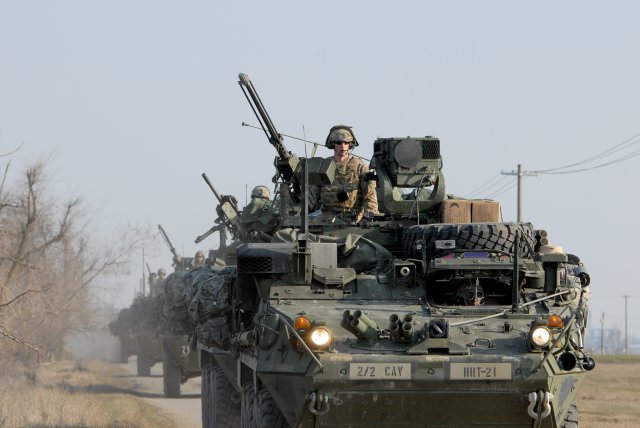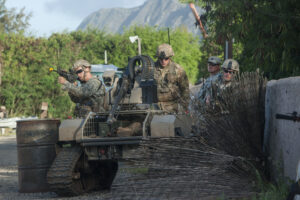Army $40B Short On Modernization Vs. Russia, China: CSA Milley
Posted on

Stryker vehicles from the Army’s 2nd Cavalry Regiment in Romania.
WASHINGTON: Congress hasn’t passed a budget for 2017, but we’re already hearing rumblings of the 2018 budget war coming from inside the Pentagon. The Army needs to radically overhaul its equipment, training, and even its culture for chaotic future conflicts against high-end adversaries like Russia and China, the largest service’s top leaders said today. But its modernization budget is up to $40 billion below the other services’. You can bet they’re pressing the same argument hard in the Defense Department’s budget deliberations.

Gen. Mark Milley
“When it comes to the modernization, the future that I’m talking about, that has a lot to do with money,” lamented Gen. Mark Milley, the Army Chief of Staff, after he summoned me for a sidebar conversation in the wake of his formal press conference with Army Secretary Eric Fanning at the Association of the US Army conference here.
“We have had a 75 percent reduction in our modernization accounts in the last eight or nine years, 30 percent as the secretary says in the last four years,” Milley said, expanding on Fanning’s talking points in the press conference. “Relative to other services, we spend about $36 to $40 billion less in modernization than either the Navy or the Air Force does,” he said with a rueful chuckle. “That’s a huge amount of money.”
But the Army doesn’t build stealth bombers or nuclear submarines. What does it need so much money for? Last year at AUSA, Milley emphasized readiness — the training, maintenance, and logistics required to “fight tonight.” This year, while near-term readiness is still four years away from a full recovery and remains Priority No. 1, Milley told reporters, “I want to emphasize… the deeper future — modernization and future concepts.”
“We are on the cusp of a fundamental change in the character of ground warfare,” a revolution perhaps five to 10 years away, Milley said. His vision of those future wars is unnerving. As the Army turns from interminable counterinsurgencies in Afghanistan and Iraq to nation-states such as Russia, China, North Korea, and Iran, Milley foresees a battlefield that “is going to be intensely lethal, the likes of which the United States Army, the United States military, has not experienced…since World War II.”

A soldier mans a robot-carried machinegun during the Army’s PACMAN-I experiment in Hawaii.
But it won’t be just World War II reprised with higher tech, or even the World War III envisioned in the 1980s. Instead, Milley said, long-range precision weapons will hammer big, obvious targets — like US headquarters today — and force both sides to disperse, into small units moving independently with no semblance of a front line. Electronic and cyber warfare — jamming and hacking — will disrupt communications among these scattered units, forcing junior commanders to take the initiative as never before.
“We talk about that all the time,” Milley said. “We say mission tactics, and auftragstaktik and all that kinda stuff, but, in fact, we still practice centralized, top-down, orders-driven operations. I don’t think that method of training our soldiers will prevail in future conflict against a near-peer competitor.”
“Our leaders, then, are going to have to be self-starters,” Milley said. “They’re going to have to have maximum amounts of initiative….critical thinking skills….(and) character, so they make the right moral and ethical choices in the absence of supervisions under intense pressure in combat.” And senior leaders — no longer able to pick up a radio or send an email and micromanage — will have to trust their juniors “implicitly.”
The new way of warfare must be joint, Milley added, rather than the preserve of just one or two services. In the 1980s, he recalled, the Army and Air Force co-developed AirLand Battle, a doctrine for stopping a Soviet invasion of Western Europe that later inspired the Gulf War ground campaign. In the last decade, the Navy and Air Force co-developed Air-Sea Battle, a vision of long-range, high-tech warfare in the Pacific against China. Each of those concepts covered “two domains,” Milley said, but in the future, US forces must “operate in all domains simultaneously” — not just air, sea, and land, but space and cyberspace as well.
Nor can the Army simply rely on the Air Force to defeat air threats, the Navy to defeat threats at sea, and so on. The Army’s emerging Multi-Domain Battle concept calls for more land-based anti-aircraft systems and new land-based anti-ship missiles. Said Milley, “land forces in the future are going to have to be capable and to operate in all of those domains.”
Milley spent more time on the human and intellectual dimensions of future warfare than on the materiel, but he made clear tech matters. In the near term, he focused on the Mobile Protected Firepower project, an air-deployable light tank — or something similar — that would provide vital covering fire to light infantry units. In the far term, he predicted a major role for robots on the battlefield.
Even as the Army focuses on future high-tech wars, however, it can’t forget all it has painfully learned about guerrilla fighting, Milley said. “We have to be able to do both of those simultaneously,” he emphasized.
“As we look towards the future, we’ve got to maintain and sustain the counterinsurgency and counterterrorist capabilities that we’ve developed and refined to a high level of expertise,” Milley said. “We have to sustain that.”
Subscribe to our newsletter
Promotions, new products and sales. Directly to your inbox.
